Knowing how to divide your garbage is as I wrote before very important in Japan. What I have written here is what I think is pretty much the same all over Japan but it may very well be different where you are so I strongly advice you to take some time and find out what the rules are in your area.
How to divide your garbage/trash
Garbage is divided into 5 big groups;
Burnable Trash
So called biodegradable trash;
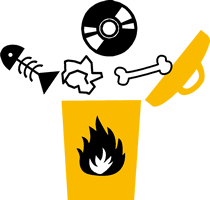
- kitchen scraps, raw trash, left over food etc.
- paper scraps, tissue
- leather scraps
- plastics
- others; leaves, tree twigs, small pieces of wood, small pieces of textile
- Advice
- Drain kitchen scraps of water.
- Absorb oil in paper (newspapers or such).
- If you have trash you don't want other people to see, like sanitary items etc, put them in a small plastic bag (like the shopping bags you get at the supermarket) or wrap in newspapers before putting into the designated garbage bag.
Some cities have special stickers for "burnable" & "non-burnable" garbage and will not take away any bags that don't have those stickers on them so please check with your local city office.
Non Burnable Trash
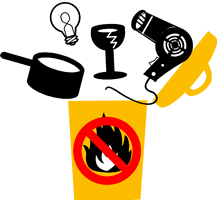
- metal items
- glass products (mirrors, fluorescent light bulbs) etc
- ceramics/pottery items (cups, plates, vases) etc
- cutlery (knives, scissors) etc
- batteries (dry cell batteries)
- small electric appliances (hot water pots, iron, toaster) etc
- Advice
- When disposing of sharp objects like, knives, broken glass etc, wrap them carefully and write キケン (dangerous) on the wrapping to prevent any injures. Be sure to use the designated bags only.
Recyclable Trash
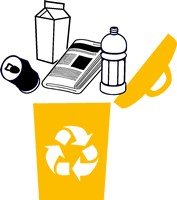
- PET bottles
- styrofoam trays
- newspapers, magazines, cardboard boxes, milk cartons
- glass bottles, that have contained food or beverages
- aluminum/steel cans, that have contained food or beverages
- old clothing, textile
- things with recycle symbols on them (see "EarthOdyssey")
- Advice
- How recyclable things are collected varies very much. At some cities, Pet bottles, styrofoam trays, milk cartons are often collect at the local supermarkets. Cans & bottles, newspapers & old clothing are often collected by the local associations, please ask at your local city office (or your neighbors) for details.
Large Size Trash
Large size garbage is the most troublesome to dispose of.
The way it is done differs a bit from place to place but in general it is done as following:
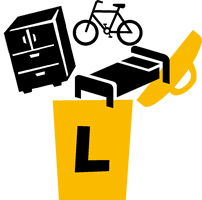
- 1) Phone the local city's garbage collection office and confirmed:
- the cost (usually a couple of hundred yen for each piece)
- where to buy the "large garbage disposal sticker"
- when you can put it at the garbage collection place
- 2) buy the "large garbage disposal sticker" at the designated store
- 3) write your name on it
- 4) stick it on the large size garbage
- 5) put it at the garbage collection place at the told time
Electric Appliance Recycling
The following electric appliances are being collected at a special "re-cycle" fee + transportation fee.
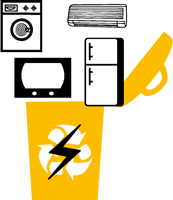
- air conditioners(3,150 yen + transportation fee)
- TV sets(2,835 yen + transportation fee)
- refrigerators/freezers(4,830 yen + transportation fee)
- washing machines(2,520 yen + transportation fee)
- Advice
- If you buy a new electric appliance, the store will often take away your old one for free or for a small fee.
Waste that can NOT be Collected
- automobile parts (car batteries, tires, etc) or motorcycles
- dangerous goods (fire extinguisher, kerosene, paint, agrichemicals, gas cylinders,etc)
Do NOT throw your large garbage (or any kind of garbage for that matter) where you are not supposed to.
Be a good neighbor, be responsible and follow the rules.

 Burnable
Burnable Non Burnable
Non Burnable Recyclable
Recyclable Large Size
Large Size Electric Appliance Recycling
Electric Appliance Recycling